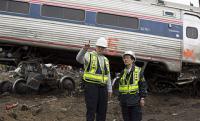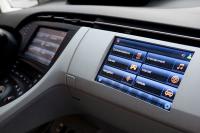-
Japan’s successful earthquake early warning system offers lessons to U.S. high-speed rail
As California and other states move forward with high-speed rail plans, some have questioned the system’s ability to withstand earthquakes. This is especially critical in California, an active quake zone. A recent research report says that valuable lessons are easily adapted from Japan’s successes with its early earthquake warning (EEW) systems. This was most recently demonstrated during the series of violent quakes that shook Japan in mid-April, 2016.
-
-
Airflow study to be conducted in NYC Subway
The Department of Homeland Security (DHS) Science and Technology Directorate (S&T) will conduct a week-long airflow study in portions of the New York City (NYC) subway system to gather data on the behavior of airborne particles in the event contaminants were released. This study poses no risk to the general public and will run from 9 to 13 May.
-
-
Terrorists have been targeting transportation hubs for decades

More than 7,400 terrorist attacks worldwide between 1970 and 2014 targeted some form of transportation, including airports and aircraft, representing 5.3 percent of all terrorist attacks. More than 460 targets of terrorist attacks between 1970 and 2014 were airports, representing 6.4 percent of all transportation targets. More than 130 targets of terrorist attacks between 1970 and 2014 were subway systems, representing 1.9 percent of all attacks on transportation targets.
-
-
Navigations systems are vulnerable to hackers
When it comes to route planning, drivers have almost blind faith in GPS. The technology plays an important role in identifying location and time in other areas, too. If hackers attack the system, they can cause great damage. Information security researches look to develop defensive measures.
-
-
Rail safety delays; Chicago’s trigger-happy police; killing Bangladeshi bloggers

In October the Congress agreed to extend the deadline for installing the systems to 2018, but earlier this month Congress extended the deadline for deploying speed-control systems yet again, this time until the end of 2020; By June 2016, all Chicago police officers will be equipped with non-lethal Tasers. The move is part of a plan by city authorities to curb the sharp rise in the number of people – all of them African Americans — killed by police shooting; in 2015 alone, at least four pro-democracy bloggers and a publisher were murdered while others went into hiding, or fled abroad, prompting widespread calls for protection of free speech in Bangladesh from the threat of radical Islamists.
-
-
Rail line service disruptions caused by sea level rise to increase dramatically
Rail services to and from the South West of England could be disrupted for more than 10 percent of each year by 2040 and almost a third by 2100, a new study suggests. The cost of maintaining tracks and sea defenses could also soar as predicted sea level rises, coupled with coastal storms and floods, pose major challenges for rail operators and governments.
-
-
Protecting vehicles from cyberattacks

The Department of Homeland Security (DHS) Science and Technology Directorate (S&T) has awarded two grants for the development of technologies that can help defend government and privately owned vehicles from cyberattacks. “Modern vehicles are no longer purely mechanical systems,” said Dr. Dan Massey, S&T Cyber Physical Systems Security (CPSSEC) Program Manager. “Today’s vehicles have interdependent cyber components used for telematics, conveniences, and safety-critical systems. A stealthy adversary could gain access to a vehicle’s cyber components and remain completely hidden until initiating a widespread attack.”
-
-
Researching cyber vulnerabilities in computer-controlled cars may violate copyright law
The advent of computer controlled, Internet-capable vehicles is offering fertile new ground to hackers. Groups of “white hat” hackers have already demonstrated the vulnerabilities inherent in the new cars’ computer systems – by taking control over a car from ten miles away. One problem in addressing the issue is that the control software is proprietary, and is owned by the developers, and researching it to uncover flaws may be a violation of copyright laws.
-
-
Thwarted train attack in France highlights U.S. rail vulnerability
Airports are protected by several layers of security, but railroad stations have minimal, if any, protective measures, and there are no security checks through which those who take the train must pass. The attempted attack on the high-speed train from Brussels to Paris, an attack foiled by the quick courageous action of three Americans and Briton, only highlights the vulnerability to attack of U.S. rail. Security experts say, however, that trains remain vulnerable to terrorist attacks. A recent study, which analyzed terrorist attacks over a 30-year period from 1982 to 2011, found that terrorists have shifted their focus in recent years away from attacking airlines to attacking subway and rail systems. The deadliest attacks in the decade 2002-2011 were against subway and commuter rail systems.
-
-
Hackers take remote control of a Jeep, forcing it into a ditch
Security experts have called on owners of Fiat Chrysler Automobiles vehicles to update their onboard software to make their vehicles better protected against hackers. The call comes after researchers demonstrated they could hack and take control of a Jeep over the Internet. The researchers disabled the engine and brakes and crashed the Jeep into a ditch – while the driver was sill behind the wheel.
-
-
Sensors can help railways detect, cope with electromagnetic attacks
Eleven years ago the Madrid train bombings proved how much European railway security still needed to be improved. Now that rail equipment — like in most other industries — is increasingly standardized and connected, however, another, more insidious type of offensive has become likely: electromagnetic (EM) attacks. An EU-funded project has developed detection technologies that can help the sector face this new threat. Virginie Deniau, coordinator of the SECRET project, discusses the devices developed by her team to identify electromagnetic (EM) attacks as they occur so that operators can switch to a safe railway mode.
-
-
Chicago, center of fracking oil shipments, debates rail safety
Chicago is home to the busiest crossroads of the nation’s rail network, and the country’s boom in oil fracking has led the city to see not only a massive increase in crude oil transferred by rail in the region, but also debates about the public safety of such an influx. The Windy City has experienced a 4,000 percent increase in oil train traffic since 2008, with many of the densely packed suburbs surrounding the city located very close to rail lines and switches.
-
-
Washington State requires railroads to plan for the “largest foreseeable spill”
Washington State governor Jay Inslee (D) has signed a new state law last month which requires railroad companies to plan with the state for the worst possible conditions when shipping crude oil. The law will require companies to plan for the “largest foreseeable spill in adverse weather conditions.” Much of the impetus for the new bill came after BNSF told Washington emergency responders in April that the company considers the worst-case spill scenario to involve 150,000 gallons of crude oil from the Bakken region, which includes parts of North Dakota, Montana, and Saskatchewan, Canada. That amount of crude is carried by five tanker cars — but BNSF crude-oil trains often consist of 100 or more rail tank cars.
-
-
A growing threat: Car hacking
A string of high-profile hacks — the most recent on President Obama’s personal email account — have made cybercrime an ever-growing concern in the United States. Despite the publicity, most people still think of hacking as something which is done only to information systems like computers and mobile devices. In reality, hacking is no longer confined to the information world. The level of automation in modern physical systems means that even everyday automobiles are now vulnerable to hacking. Researchers are now looking into the growing threat of automotive hacking. “More and more in your everyday life you see that we’re automating physical systems,” one researcher says. “And unlike an information system, a physical system could kill you by accident.”
-
-
Positive train control could have prevented Amtrak derailment, but it’s not quite on track
Positive train control (PTC), a safety technology for rail transportation, may have been able to prevent the 12 May 2015 accident in which a northbound Amtrak Northeast Regional Train 188 carrying 238 passengers to New York from Washington, D.C. derailed near Philadelphia. PTC is a system designed to prevent train-to-train collisions, over-speed derailments, incursions into established work zone limits, and the movement of a train through a switch left in the wrong position. The Railroad Safety Improvement Act of 2008 (RSIA08) mandated that PTC must be implemented on about 60,000 miles of U.S. track by the end of 2015. The Federal Railroad Administration (FRA) estimates that the total capital cost for full PTC deployment according to law would be about $10 billion (about one year’s worth of capital investments for the major U.S. railroads) and annual maintenance costs of $850 million. The costs of implementing PTC remain a significant barrier – but not the only barrier. In addition to costs, PTC has faced barriers in technical implementation, namely system interoperability and allocation of communication spectrum.
-
- All
- Regional
- Water
- Biometrics
- Borders/Immig
- Business
- Cybersecurity
- Detection
- Disasters
- Government
- Infrastructure
- International
- Public health
- Public Safety
- Communication interoperabillity
- Emergency services
- Emergency medical services
- Fire
- First response
- IEDs
- Law Enforcement
- Law Enforcement Technology
- Military technology
- Nonlethal weapons
- Nuclear weapons
- Personal protection equipment
- Police
- Notification /alert systems
- Situational awareness
- Weapons systems
- Sci-Tech
- Sector Reports
- Surveillance
- Transportation
Advertising & Marketing: advertise@newswirepubs.com
Editorial: editor@newswirepubs.com
General: info@newswirepubs.com
2010-2011 © News Wire Publications, LLC News Wire Publications, LLC
220 Old Country Road | Suite 200 | Mineola | New York | 11501
Permissions and Policies
Editorial: editor@newswirepubs.com
General: info@newswirepubs.com
2010-2011 © News Wire Publications, LLC News Wire Publications, LLC
220 Old Country Road | Suite 200 | Mineola | New York | 11501
Permissions and Policies
